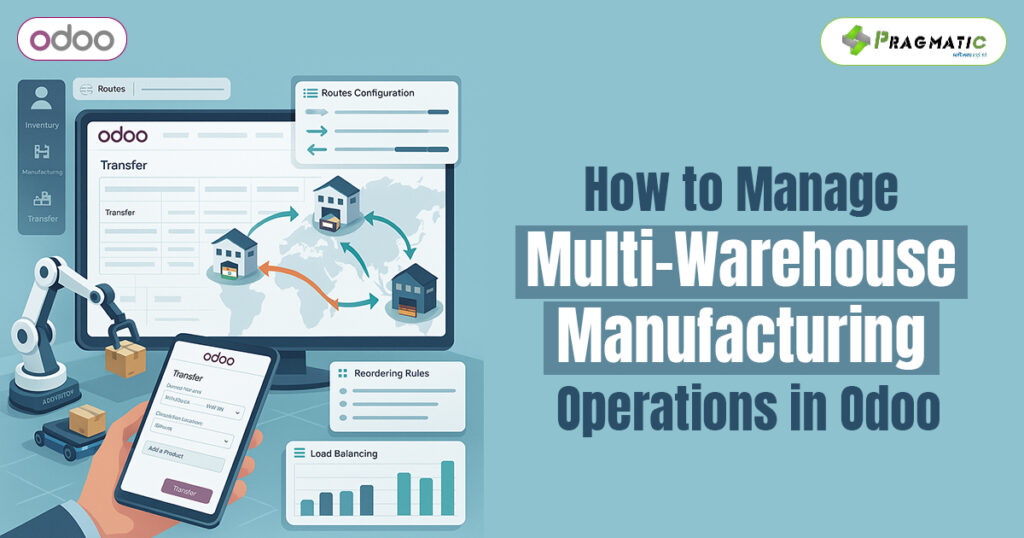

Managing multiple warehouses across regions or countries has become a dynamic challenge for modern manufacturers in 2025. With global supply chains growing more complex and customer expectations rising, businesses must maintain synchronized inventory, minimize delays, and reduce overhead. Fortunately, Odoo multi-warehouse management provides a powerful suite of tools to streamline operations, balance inventory load, and enhance fulfillment efficiency.
In this article, we’ll explore how to effectively manage multi-warehouse manufacturing operations in Odoo 18, the latest version of the popular open-source ERP. We’ll dive deep into warehouse routes, push/pull rules, inter-warehouse transfers, and load balancing strategies that business owners and operations managers can implement to attain operational excellence.
As we step into 2025, manufacturers are facing significant shifts:
All this translates to a need for smarter warehouse management. Odoo 18 has addressed these trends with enhanced warehouse routing, automation tools, and integrated manufacturing workflows—making it easier than ever to scale operations across multiple sites.
Before configuring routes or transfers, you need to ensure multi-warehouse functionality is enabled.
1. Go to: Inventory → Configuration → Settings
2. Under the Warehouse section, enable Multi-Step Routes and Storage Locations.
3. Make sure “Manage multiple warehouses” is checked.
4. Create each warehouse through Inventory → Configuration → Warehouses.
Each warehouse can now have separate incoming, internal, and outgoing locations to manage stock independently.
Routes in Odoo define the paths products follow through your inventory—across warehouses or between production and delivery. For multi-warehouse setups, custom routes enable precise control over stock movement.
To create custom warehouse routes in Odoo 18:
1. Navigate to Inventory → Configuration → Routes.
2. Click Create, and name your route (e.g., “Route to Main Warehouse”).
3. Add rules such as:
A well-defined route can automate stock transfers to ensure inventory is always where it’s needed—especially crucial for MTO (Make to Order) and MTS (Make to Stock) operations.
Push and pull rules are the engines behind smart inventory flow in Odoo’s route system. Here’s how they work:
To configure them:
1. Within your created route, click Add a Rule.
2. Choose the rule type:
3. Set the operation type (e.g., Manufacturing, Internal Transfer).
4. Assign source and destination locations.
With these rules, you can shape the entire fulfillment lifecycle—from inbound shipments to internal manufacturing requests and outbound logistics.
Transfers between warehouses are a core function of Odoo multi-warehouse management. These can be done manually or automatically, based on stock thresholds or route rules.
1. Go to Inventory → Operations → Transfers.
2. Click Create → Choose Transfer Type: Internal.
3. Set the source and destination warehouses and the products to move.
4. Validate and process the transfer.
1. Go to Inventory → Products → Set a Reordering Rule.
2. Choose warehouse-specific minimum and maximum quantities.
3. Enable “Automated Orders” and link to a route between warehouses if preferred.
Odoo 18’s new transfer APIs and scheduling logic bolstered in 2025 make these movements highly efficient, reducing stockouts and overstocking.
Efficient load balancing ensures that no single warehouse gets overwhelmed while others remain underutilized. In Odoo 18, you can implement load balancing using three strategies:
1. Smart Routes with Demand Forecasting
Integrate Odoo with AI plugins or third-party forecasting tools that model demand by region. Configure dynamic routes that adjust based on sales trends and factory capacity.
2. Prioritized Pull Rules
Prioritize warehouses based on geography, cost-efficiency, or stock levels. For example:
– Pull from nearest warehouse with lowest shipping cost.
– Prioritize warehouse with surplus inventory.
3. Scheduled Inventory Equalization
Use Odoo’s Automated Actions to periodically execute internal transfers to redistribute stock across warehouses.
Example:
– Every Friday, an automated rule checks stock levels and initiates transfers if any location surpasses 150% of its reorder max.
These automated and semi-automated strategies ensure stock is aligned with production and customer demand—crucial for reducing lead times and carrying costs in 2025.
Multi-warehouse management shines when paired with Odoo’s Manufacturing module. Ensure that:
With Odoo 18’s tighter integration between inventory and production, tracking WIP (work-in-progress), quality checks, and traceability across warehouses is faster and more visual—especially with the updated barcode scanning tools and mobile app features in 2025.
In today’s distributed manufacturing landscape, mastering Odoo multi-warehouse management can translate into faster fulfillment, lower costs, and better customer satisfaction. Odoo 18 brings enhanced flexibility to configure customized routes, automate transfers, and maintain real-time inventory visibility.
Whether you’re scaling production globally or looking to streamline complex logistics, implementing these features is a strategic step forward. As we navigate the evolving supply chain trends of 2025, investing in robust warehouse coordination has never been more vital.
Need help setting up or optimizing your multi-warehouse operations in Odoo?
Connect with our team of Odoo experts. We’ll help you configure a scalable, automated system tailored to your unique business workflow.
👉 Let’s talk Odoo. Reach out today for a free consultation.
Leave a Reply
You must be logged in to post a comment.